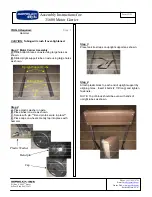MPC555
/
MPC556
CAN 2.0B CONTROLLER MODULE
MOTOROLA
USER’S MANUAL
Rev. 15 October 2000
16-14
Once these steps are performed, the message buffer functions as an active receive
buffer and participates in the internal matching process, which takes place every time
the TouCAN receives an error-free frame. In this process, all active receive buffers
compare their ID value to the newly received one. If a match is detected, the following
actions occur:
1. The frame is transferred to the first (lowest entry) matching receive message
buffer
2. The value of the free-running timer (captured at the beginning of the identifier
field on the CAN bus) is written into the time stamp field in the message buffer
3. The ID field, data field, and RX length field are stored
4. The code field is updated
5. The status flag is set in the IFLAG register
The user should read a received frame from its message buffer in the following order:
1. Control/status word (mandatory, as it activates the internal lock for this buffer)
2. ID (optional, since it is needed only if a mask was used)
3. Data field word(s)
4. Free-running timer (optional, as it releases the internal lock)
If the free running timer is not read, that message buffer remains locked until the read
process starts for another message buffer. Only a single message buffer is locked at
a time. When a received message is read, the only mandatory read operation is that
of the control/status word. This ensures data coherency.
If the BUSY bit is set in the message buffer code, the CPU should defer accessing that
buffer until this bit is negated. Refer to
.
NOTE
The user should check the status of a message buffer by reading the
status flag in the IFLAG register and not by reading the control/status
word code field for that message buffer. This prevents the buffer from
being locked inadvertently.
Because the received identifier field is always stored in the matching receive message
buffer, the contents of the identifier field in a receive message buffer may change if
one or more of the ID bits are masked.
16.4.4.1 Receive Message Buffer Deactivation
Any write access to the control/status word of a receive message buffer during the pro-
cess of selecting a message buffer for reception immediately deactivates that mes-
sage buffer, removing it from the reception process.
If a receive message buffer is deactivated while a message is being transferred into it,
the transfer is halted and no interrupt is requested. If this occurs, that receive message
buffer may contain mixed data from two different frames.
F
re
e
sc
a
le
S
e
m
ic
o
n
d
u
c
to
r,
I
Freescale Semiconductor, Inc.
For More Information On This Product,
Go to: www.freescale.com
n
c
.
..


















